Architects & Firms
From the elevated platform of an adjacent Chicago Transit Authority station, the new headquarters of the Chicago Park District appears as a shimmering two-story disc set on a blanket of grass, its platonic roundness interrupted only by a set of parallel brick walls that slice through the building. Formally, this latest work of John Ronan’s is defined by these two moves—the circle that bounds it in plan and the masonry walls that cut across that circle at uneven intervals—and much architectural interest derives from their interplay throughout the 78,000-square-foot building.
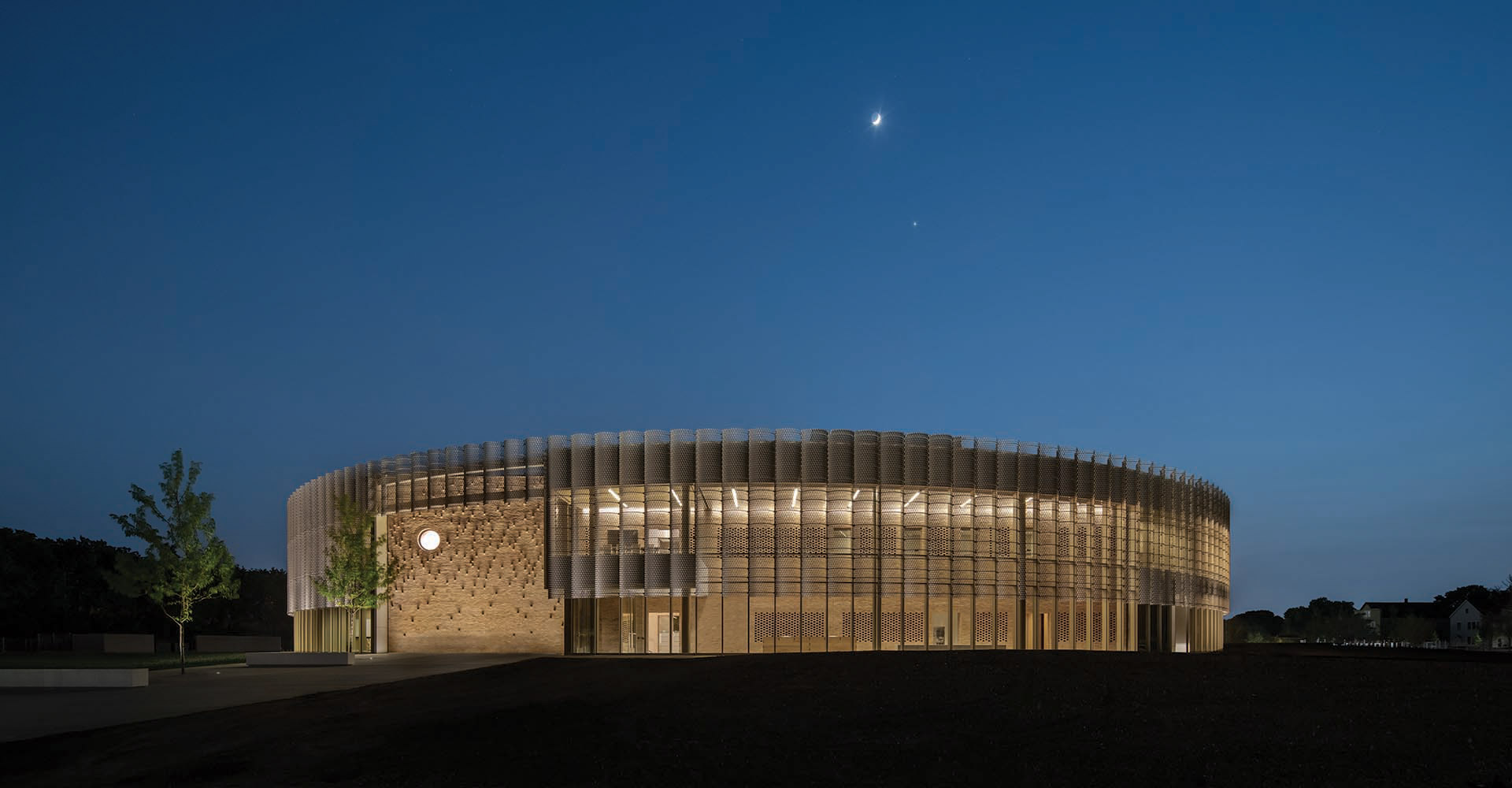
An opening in the building’s curved exterior marks its entrance. Photo © James Florio, click to enlarge.
In a manner recalling the “integrated” design solutions of Louis I. Kahn, these gestures quickly reveal themselves to the visitor as simultaneous responses to the building’s programmatic, symbolic, and structural needs. The circle, nearly 250 feet in diameter, provides the building with a recognizable civic identity appropriate for the headquarters of the agency that oversees one of the largest and most cherished collections of municipal parks in the nation. It also serves to gather those offices and related facilities together with a neighborhood field house, encompassing a multiuse basketball court, exercise rooms, outdoor terrace, and other flexible spaces, without creating a hierarchy among these various elements: a circle, after all, has no front or back. The masonry walls, built of concrete block fronted with light pink Chicago brick reclaimed from two demolished factories, form the bulk of the vertical structure and divide the circle into a series of bands housing different elements of the program. The narrowest bands house private offices, circulation spaces, and mechanical systems; wider ones offer open-plan offices and larger rooms; and an even wider area, where three bands merge into one, comprises the basketball court.
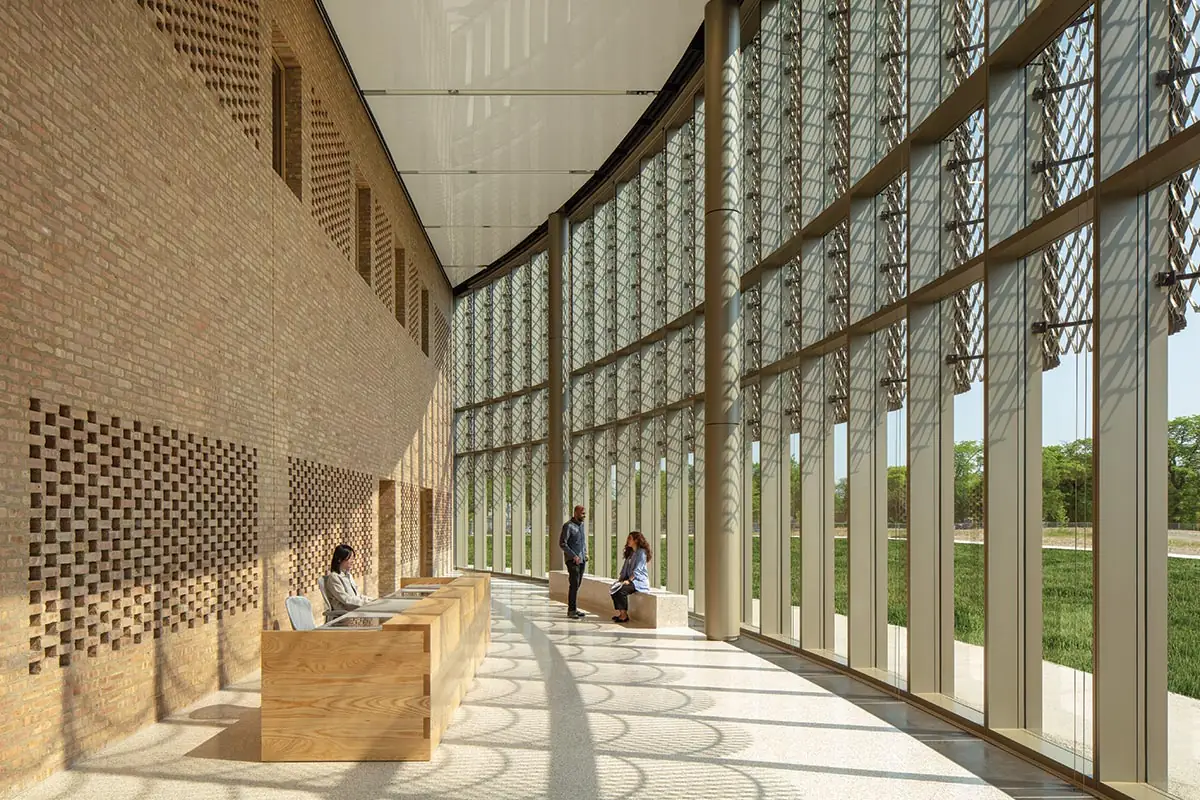
1
Structural masonry walls define its lobby (1) and basketball court (2). Photos © James Florio
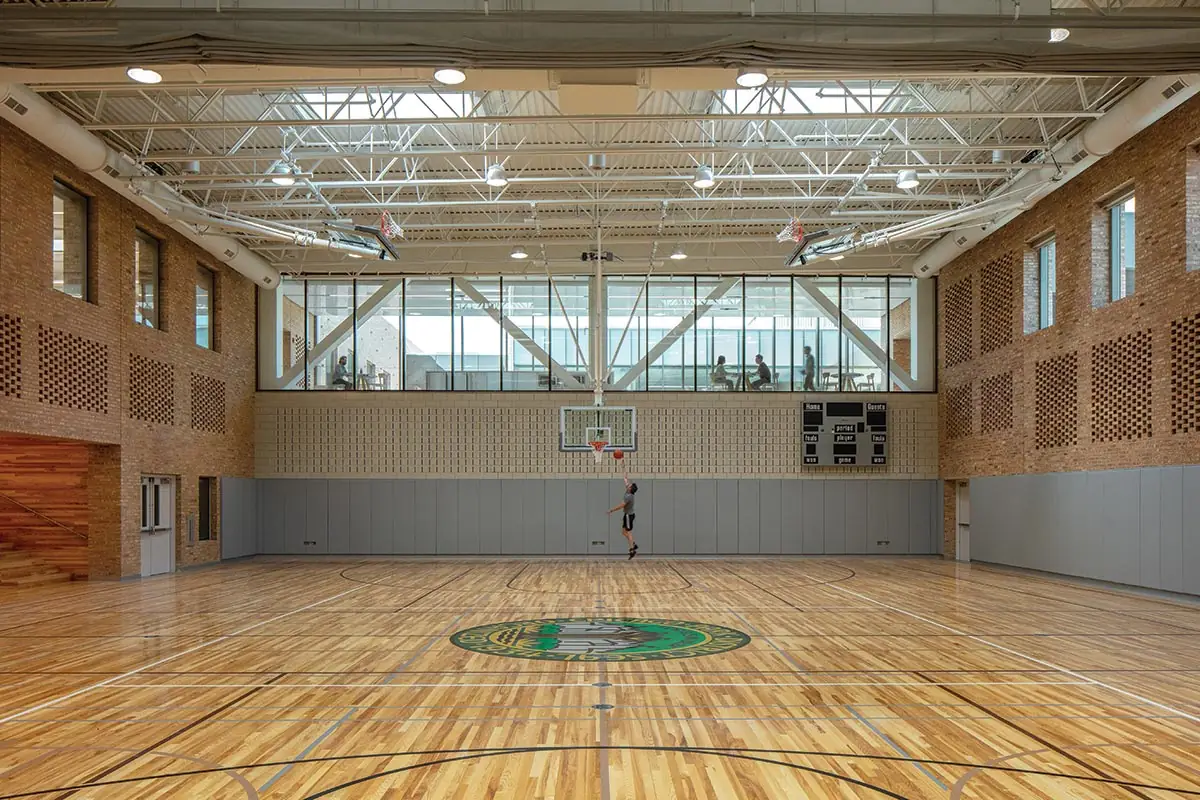
2
How unusual it is to find load-bearing masonry walls used in a genuine and purposeful way in a new American building. Again in the manner of Kahn, these walls return structure to its pre-steel-frame forcefulness in defining and delineating space. Within the Park District headquarters, one cannot forget about structure, as we do in our endlessly reconfigurable offices. The sheer weight of the masonry, and its insistent imposition throughout this building, make an argument for an architecture in which tectonic expression, which has in recent decades been relegated to the margins of the profession (at least in the United States), makes its return—not aggressively, but as a quiet alternative to dominant modes of architectural image-making. “Buildings with hero images are problematic for me,” says Ronan, and in his insistence on the tectonic he harkens back not just to Kahn but also to Aldo Van Eyck, whose Sonsbeek Pavilion (1966) in the Netherlands, with its parallel concrete block walls topped with skylights, proposed a similar mode of spatial definition.
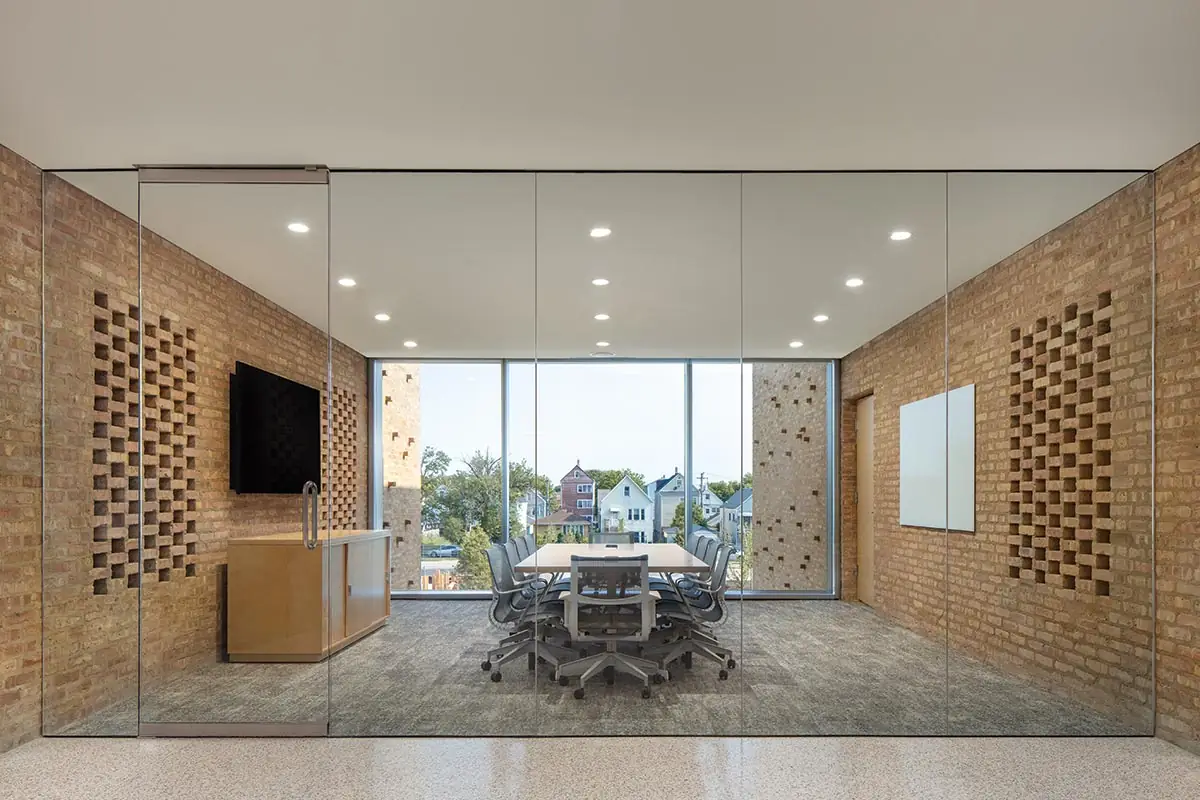
Structural masonry walls fronted with reclaimed Chicago brick define the offices within. Photo © James Florio
Ronan’s formal and material choices are also informed by the larger social-political project of which this building is a key part—that of bringing municipal agencies out of Chicago’s downtown and into the communities they serve, in this case the primarily Hispanic southwest neighborhood of Brighton Park. Both Ronan and the Park District’s staff understood that doing so meant more than transplanting the department’s drab, cubicle-dominated offices onto a new site. It meant creating a new neighborhood park and field house, and integrating into these public spaces a more open and accessible set of offices that would enable the roughly 200 Park District administrators to engage with the surrounding community and experience the services that the district provides on a daily basis. The building aims to “improve our understanding of each other,” says Heather Gleason, who, as the Park District’s director of planning and development, worked closely with Ronan since the project’s inception under mayor Rahm Emanuel in 2014.
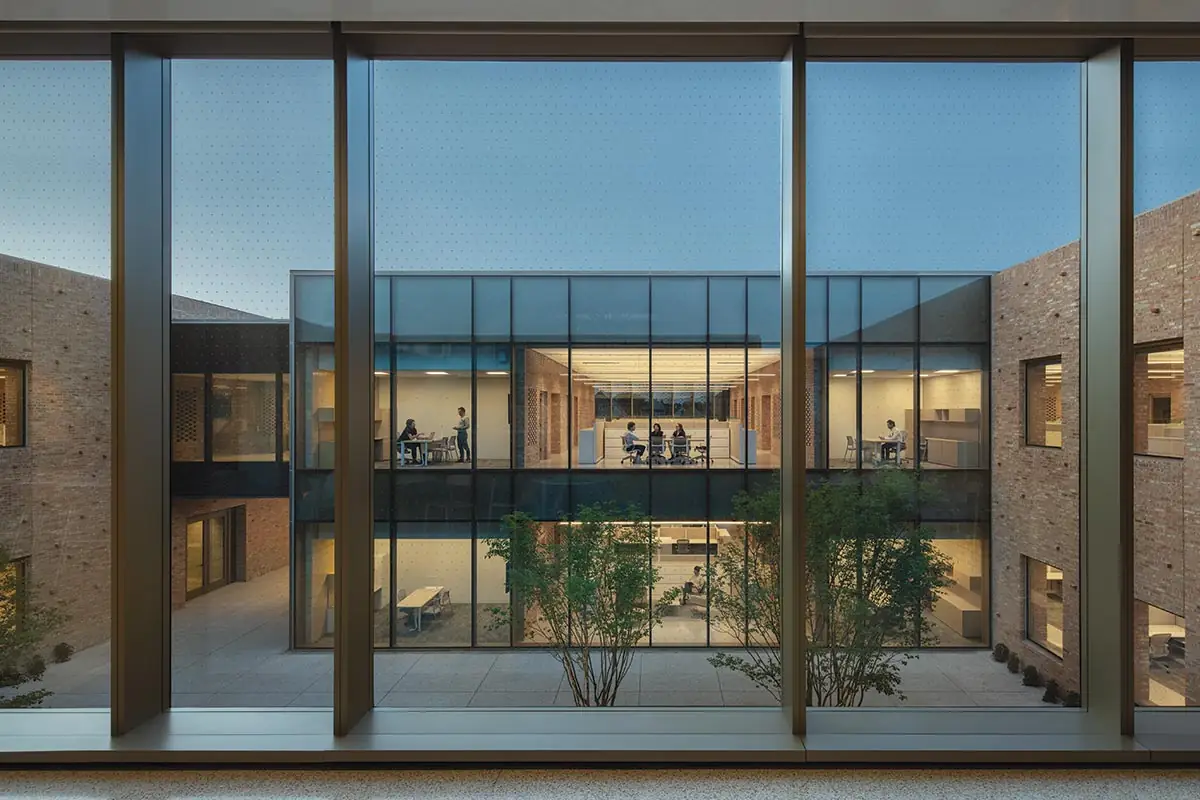
Curtain walls offer a glimpse into the offices. Photo © James Florio
The 17-acre park, designed by Ronan in collaboration with Site Design Group, features turf soccer fields, a playground, a spray water feature, open lawns, and indigenously planted meadows—all of which are sorely needed in a neighborhood that has long lacked adequate green space. A long, looping pathway encircles the park, passing directly through the headquarters building via a void carved out between the parallel masonry walls. This pathway, which opens out into two shaded courtyards in the center of the building, enables light to be brought deep into the interiors and, on the ground level, divides the field house (the western portion of the structure, facing the park) from the offices (the eastern portion, facing the street). The resulting interplay of indoor/outdoor and public/private is highly effective—one imagines that locals and staff alike will enjoy lunch in the courtyards—and comes as no surprise from Ronan, whose well-known Poetry Foundation in Chicago’s River North neighborhood and Ed Kaplan Institute at the Illinois Institute of Technology both involve similar incursions of shared outdoor spaces into a main building mass.
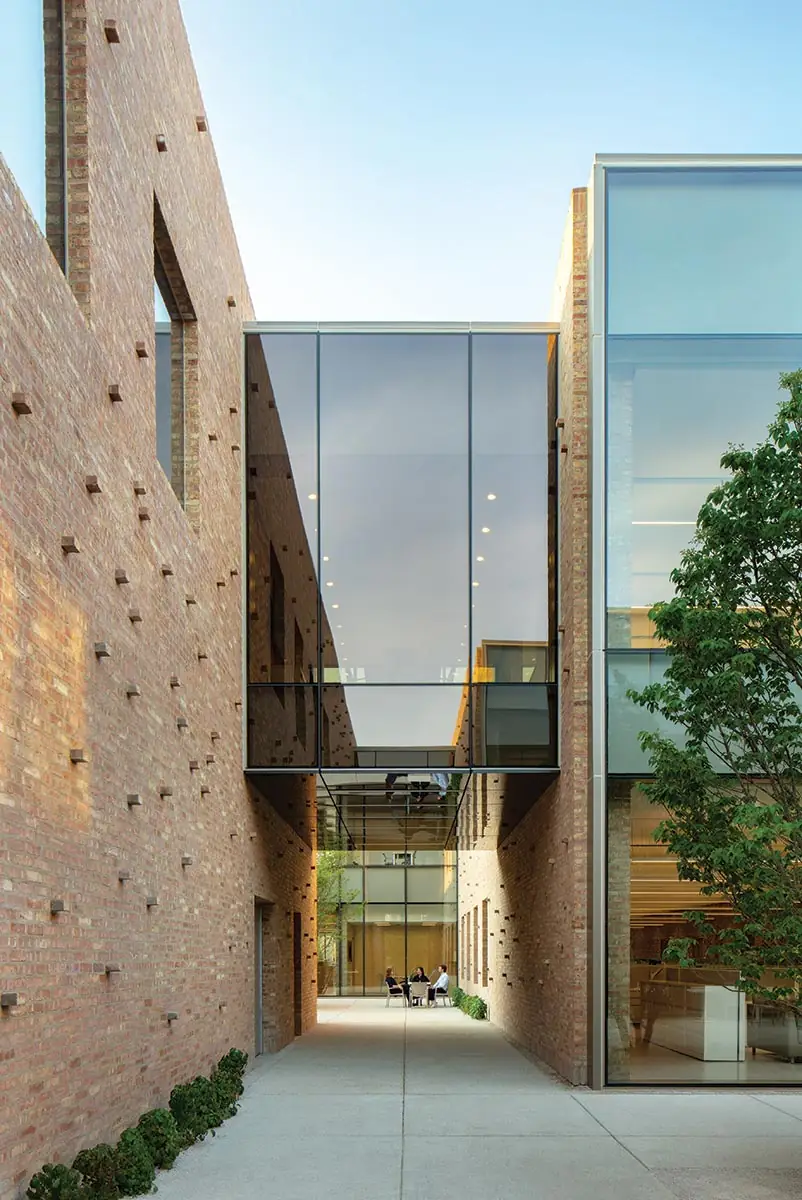
3
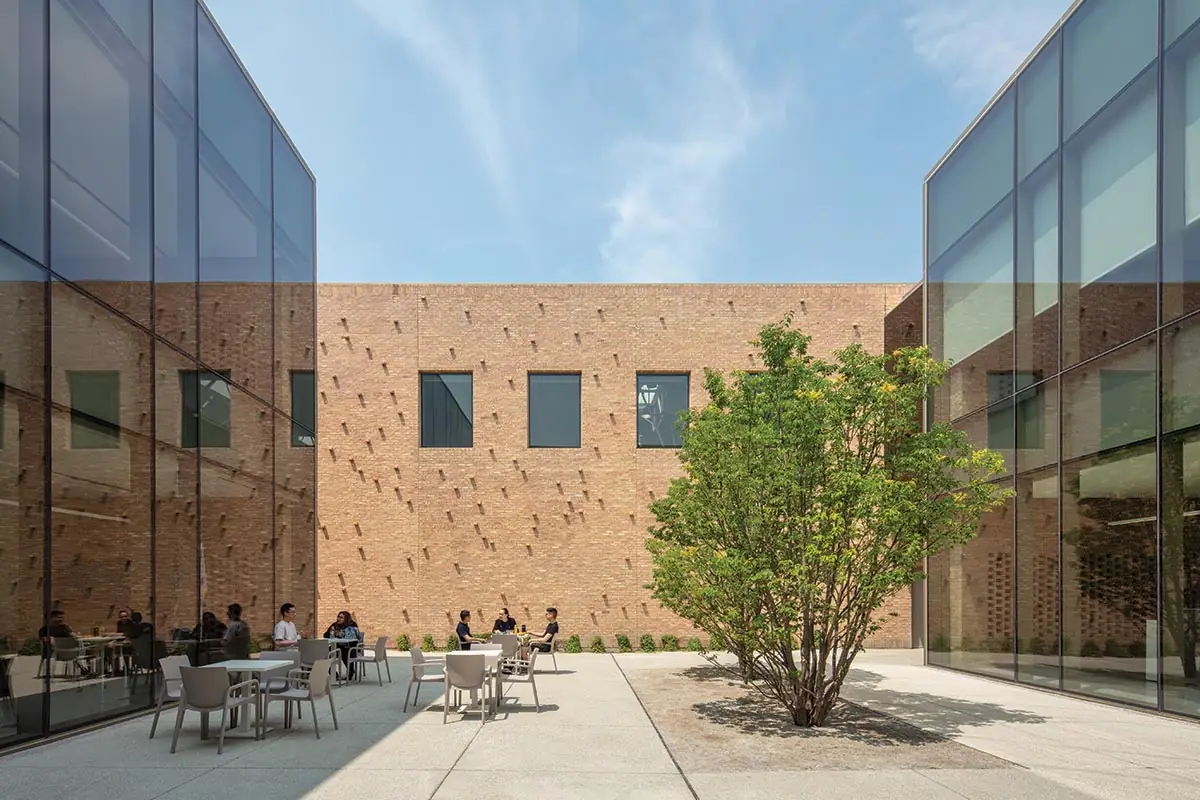
4
A set of public pathways and courtyards snake through the building (3 & 4). Photos © James Florio
The project’s execution is pleasingly straightforward. No extravagant details were insisted upon; Ronan, whose office is in Chicago and whose work is concentrated there, designed the building around the abilities of the city’s contractors—especially the low bidders who tend to win municipal contracts. The interiors are dominated by ordinary materials—terrazzo flooring, stretched-fabric ceilings, and exposed brick, some of which is perforated to enable the integration of acoustic dampening material and HVAC systems. Ash reclaimed from felled Park District trees frames doors and punched windows; a grand stair linking the two floors of offices that is entirely ash, walls included, makes for a brief moment of immersive luxury, made all the more memorable by its rarity. Only the grand, skylit basketball court, with its ash floor and bleachers and perforated brick walls, can compete.
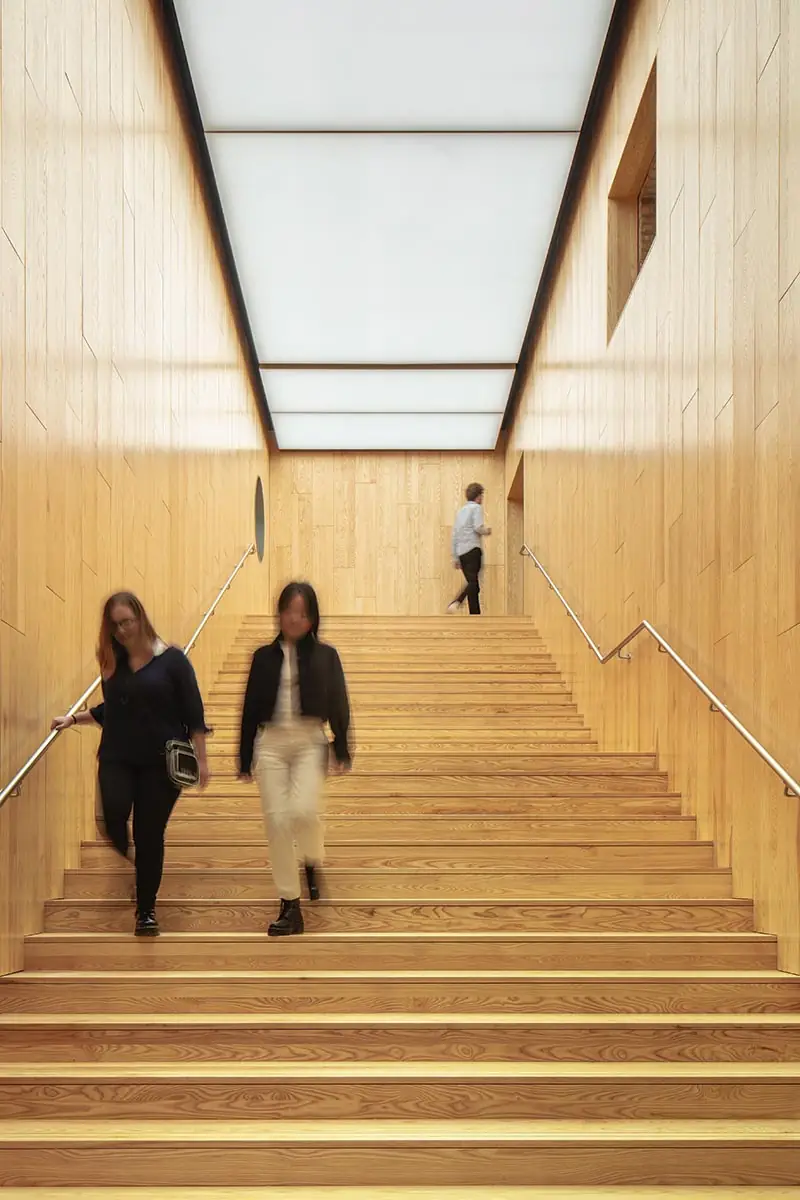
5
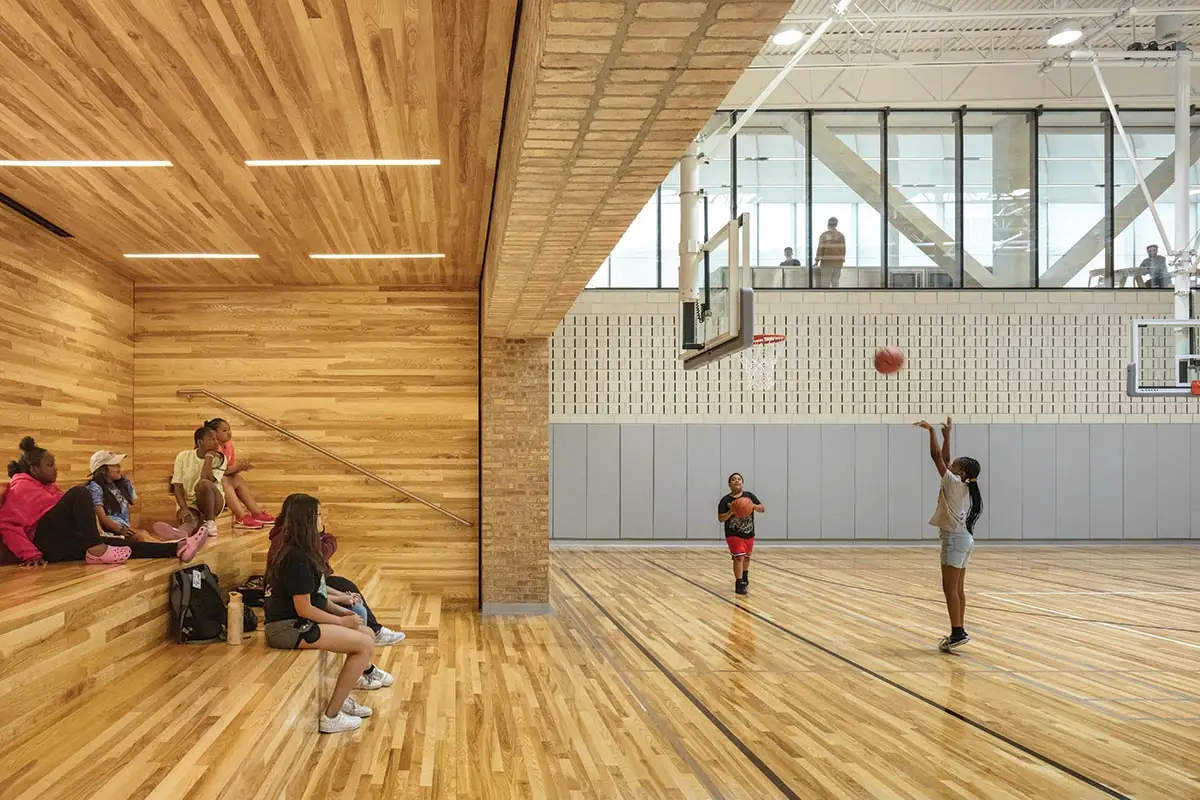
6
Reclaimed ash defines the main stair (5) and basketball court (6). A staff lounge overlooks the court (7). Photos © James Florio
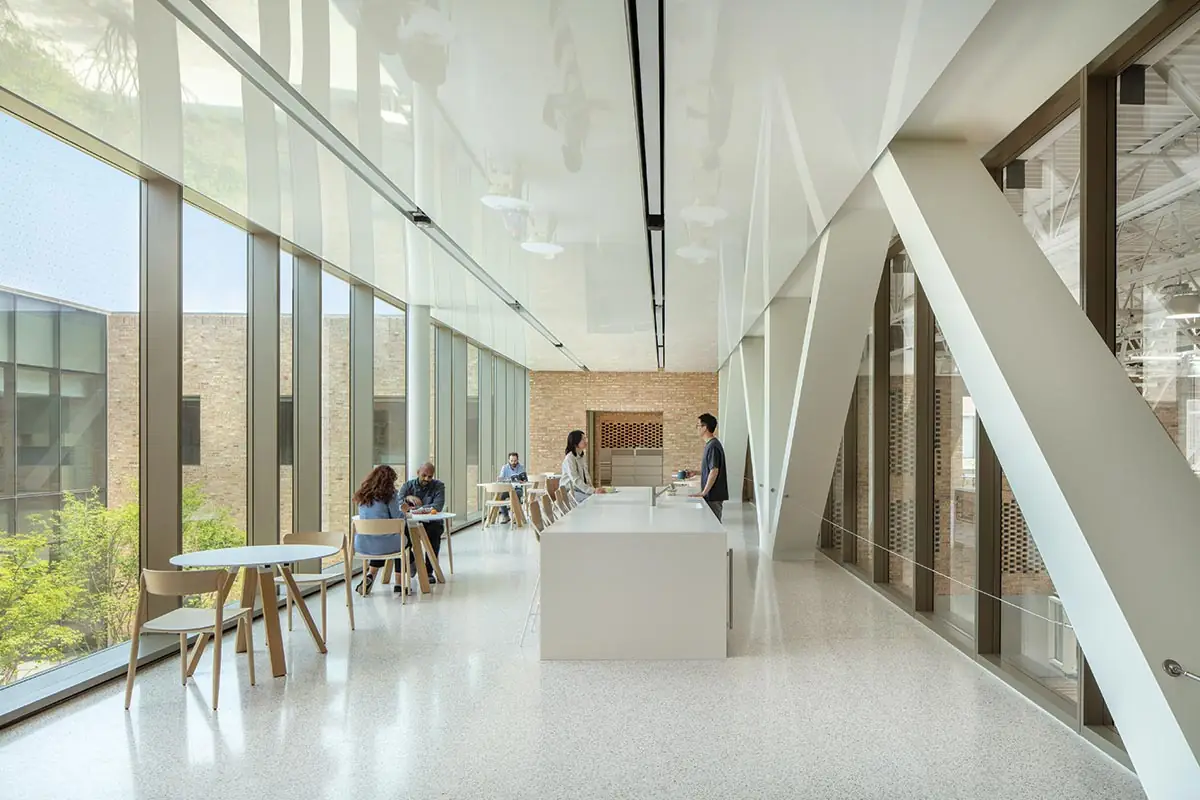
7
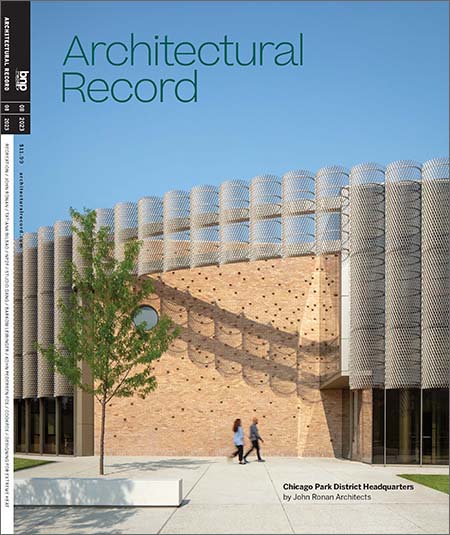
Photo © James Florio
What most passersby will remember about this building, however, is not its thoughtful interiors but rather its rounded facade, rendered in glass sheathed in a set of half-round perforated sunshades. The sunshades give the building a textural sheen and a sense of well-defined scale; they call to mind the similar shades that adorn the curving glass buildings of SANAA’s Bocconi University campus in Milan. But whereas SANAA’s buildings float ethereally above the landscape like some majestic group of airborne creatures, Ronan’s plants its masonry feet firmly in the ground. Distinctive as it is, this building remains rooted in Chicago’s architectural culture—as a walk around Brighton Park, with its lovingly maintained townhouses bracketed by structural brick side walls, makes clear. If the project is, as Ronan puts it, on one level about “reclaiming dignity” for those who do the important work of running Chicago’s parks, it is also about finding grandeur in the everyday fabric of the city. As Chicago at long last grapples with its decades-long neglect of its south and west sides, this architectural undertaking takes on an outsize significance, and suggests a viable path forward.
Click plan to enlarge
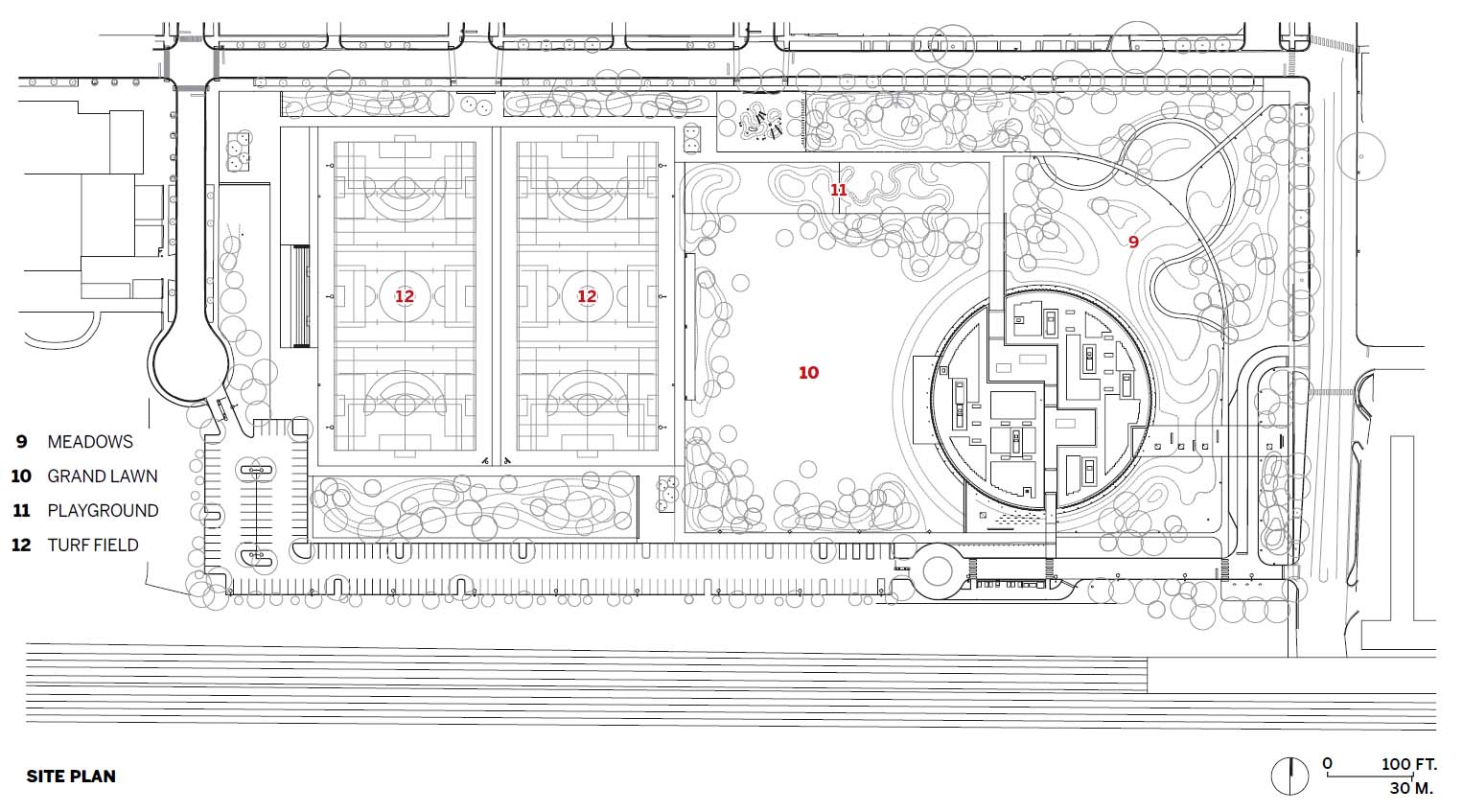
Click plan to enlarge
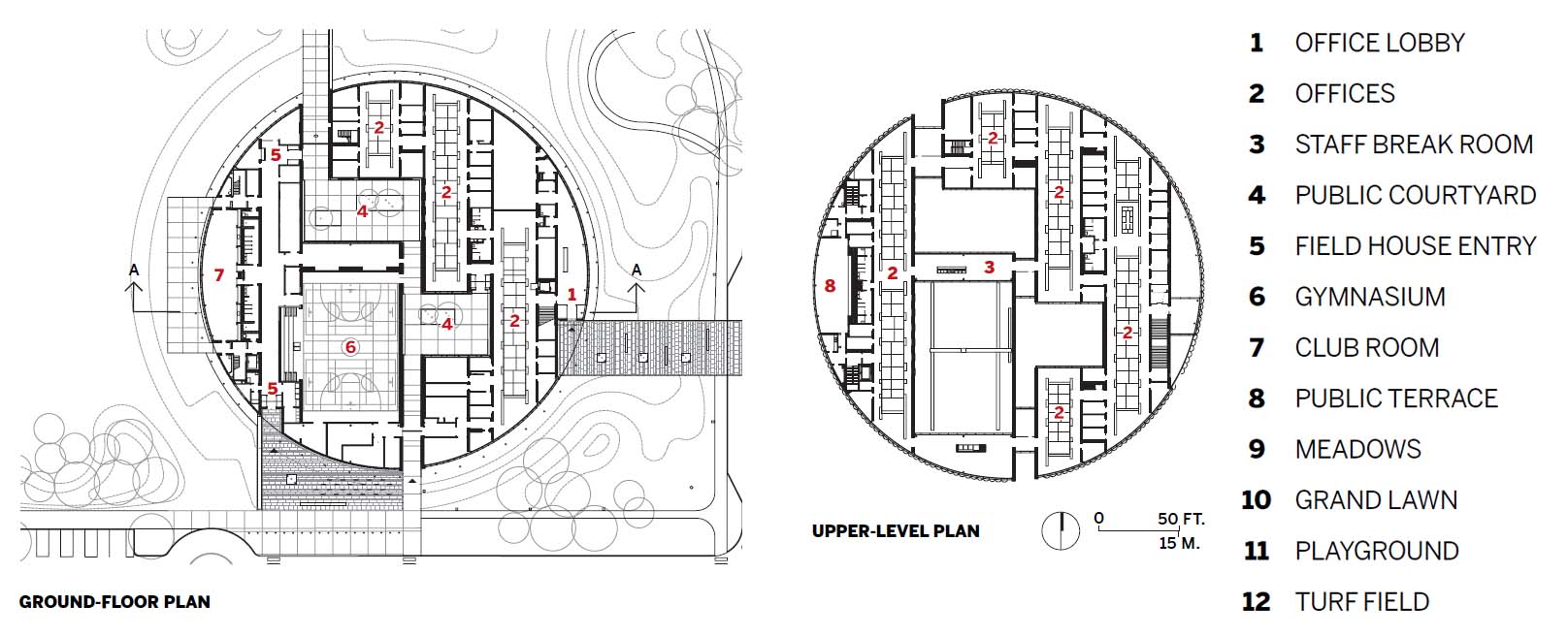
Click section to enlarge
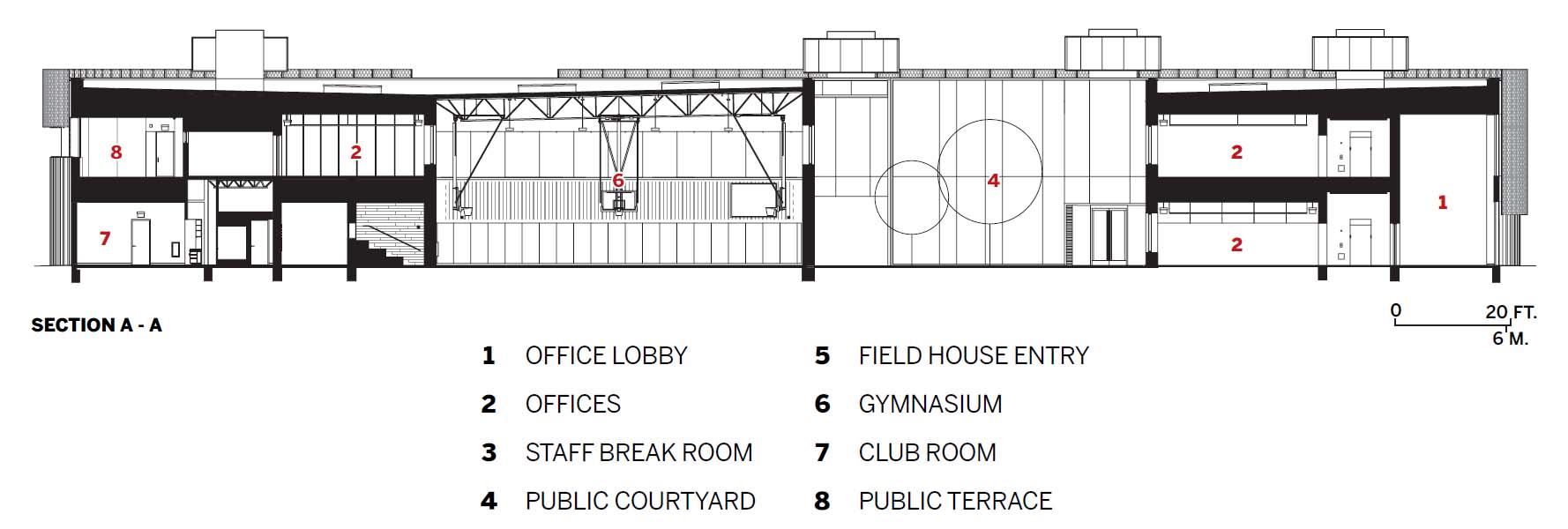
Credits
Architect:
John Ronan Architects — John Ronan, lead designer; Marcin Szef, project architect; John Kerner, Eric Cheng, Maranda Gerga, Sam Park, Phil Syvertsen, design team
Engineers:
Thornton Tomasetti (structural); dbHMS (m/e/p); TERRA Engineering (civil, traffic)
Consultants:
CharterSills (lighting); APMonarch (community engagement); Site Design Group (landscape)
General Contractor:
F.H. Paschen, ALL Construction Group
Client:
Chicago Park District
Size:
80,000 square feet
Cost:
Withheld
Completion Date:
June 2023
Sources
Exterior Cladding:
Oldcastle BuildingEnvelope (curtain wall); ALPOLIC (aluminum); Fabricated Products Group, Niles Expanded Metals, Alliance Glazing Technologies (metal sunscreen)
Interior Finishes:
Armstrong, 9Wood (acoustical ceilings); Modernfold (partitions)
Lighting:
Fluxwerx Illumination (interior ambient and downlights); WE-EF (exterior uplights)
Doors:
Oldcastle BuildingEnvelope (aluminum doors)
Plumbing:
Kohler
EV Charging: ChargePoint
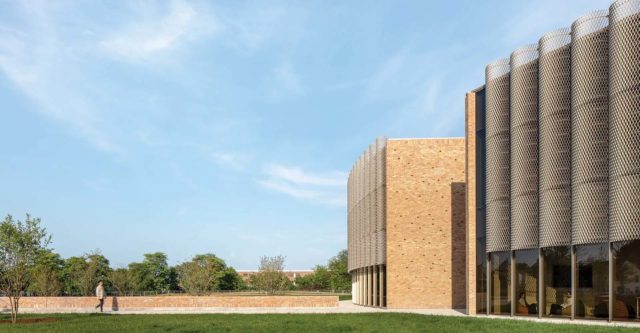


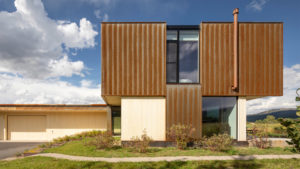
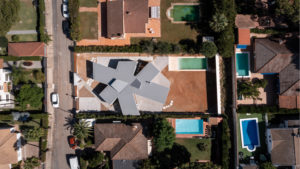
.jpg?height=300&t=1713468361&width=300)
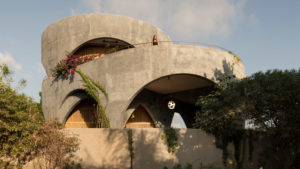
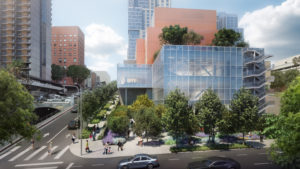
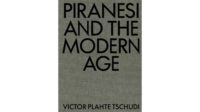

Post a comment to this article
Report Abusive Comment